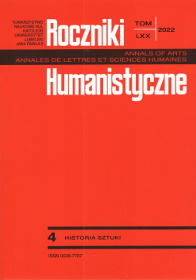Nowe spostrzeżenia na temat nagrobka królowej Jadwigi Andegaweńskiej w katedrze na Wawelu
New Observations on the Tomb of Queen Hedwig of Anjou in the Cathedral on Wawel Hill in Krakow
Author(s): Marek WalczakSubject(s): Fine Arts / Performing Arts, Architecture, History of Art
Published by: Towarzystwo Naukowe KUL & Katolicki Uniwersytet Lubelski Jana Pawła II
Keywords: 19th/20th century sculpture; sepulchral art; the Krakow cathedral; memorial sites; historicism
Summary/Abstract: In 1900, the Bishop of Krakow, Jan Puzyna, decided to erect a sarcophagus for the remains of Queen Hedwig of Anjou (d. 1399). Its founder, Count Karol Lanckoroński, gave the commission to Antoni Madeyski, a sculptor active in Rome, while the technical matters and iconographic programme of the work were entrusted to Marian Sokołowski, a professor of art history at the Jagiellonian University in Krakow. Madeyski recorded the progress of his work in photographs which reveal that initially an inscription had run along the edges of the top slab, which was obliterated after the assembly of the tomb in the cathedral. This change may have been caused by a – now long forgotten – dispute about the extent of the contribution from each of the key figures involved in the undertaking. Or perhaps the foundation inscription on the top slab, above a short text related to the queen, was deemed inappropriate in view of the plans to resume efforts for her beatification. The location of the sarcophagus was conditioned by a number of factors, one of which was the proximity of the shrine of St Stanislaus, and was possibly intended to concentrate the cults of the local saints in the area of the intersection of the naves. The forms of the tomb had no relation to the existing monuments of the monarchs of the Piast or Jagiellonian dynasties in the cathedral; in fact, local tradition was ignored, since the work was carved of white not red stone and did not have a canopy. Madeyski’s immediate model was the tomb of Ilaria del Carretto in Lucca, probably indicated to him by Lanckoroński who was very fond of Italian Quattrocento art. Of key importance must also have been the fact that both women had died in childbirth. A cenotaph to King Ladislaus III of Varna, carried out by Madeyski in 1902-1906, was modelled on the monument to Gaston de Foix in Milan. Thus, in both cases the sculptor referred to ‘icons’ of historical literature and nineteenth-century popular culture, bringing the history of Poland into the orbit of European history. Hedwig of Anjou, similar to Ilaria del Carretto, is presented as a paragon of sacrifice for religion and marital fidelity. Ladislaus III, in turn, killed in the battle of Varna in 1444, just like de Foix, a French commander who fell in the battle of Ravenna in 1512, was regarded as an exemplar of sacrifice for his homeland.
Journal: Roczniki Humanistyczne
- Issue Year: 70/2022
- Issue No: 4
- Page Range: 67-97
- Page Count: 31
- Language: Polish

